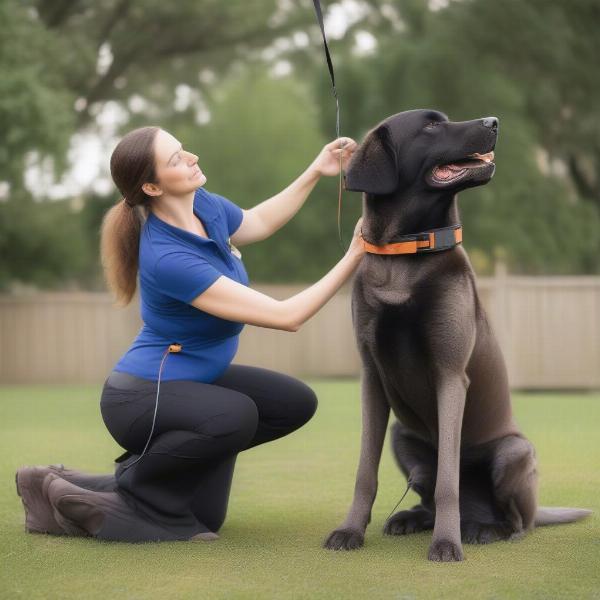Electric collars, also known as e-collars or shock collars, are a controversial training tool, particularly when used on large, powerful breeds. While they can be effective in certain situations, it’s crucial to understand their proper use, potential risks, and ethical considerations before considering one for your big dog. This guide will explore the different types of e-collars, their appropriate applications, and important safety precautions.
Understanding Electric Collars for Large Breeds
Electric collars deliver a mild electric stimulation to a dog’s neck via a receiver collar. This stimulation can range from a light tingling sensation to a more intense shock, depending on the collar’s settings. It’s essential to understand that the goal is not to inflict pain, but to interrupt unwanted behaviors and redirect the dog’s attention. For large, strong dogs, finding the right balance of stimulation is crucial. A setting that’s too low might be ineffective, while a setting that’s too high can be harmful and create fear or aggression.
Types of Electric Collars
There are several types of electric collars available, each designed for different purposes:
-
Training Collars: These are the most common type, offering varying levels of stimulation. Some models also include vibration and tone features, providing options for communication beyond static correction.
-
Bark Collars: These collars automatically deliver a stimulation when a dog barks. This can be helpful for curbing excessive barking, but it’s crucial to identify and address the underlying cause of the barking, such as anxiety or boredom.
-
Invisible Fence Collars: These collars work with buried wires to create a boundary for your dog. When the dog approaches the boundary, the collar emits a warning tone. If the dog continues, it receives a mild stimulation.
Using Electric Collars Responsibly
Electric collars should never be used as a first-line training tool. Positive reinforcement methods, such as reward-based training, should always be the foundation of your dog’s training. If you’re considering an e-collar for a behavioral issue, consult with a certified professional dog trainer experienced in their use. They can help you determine if an e-collar is appropriate for your dog’s specific situation and guide you on its safe and effective implementation. Remember, the goal is to teach your dog desired behaviors, not to punish them.
Safety and Ethical Considerations
-
Proper Fit: The collar should fit snugly but not too tight. You should be able to fit two fingers comfortably between the collar and your dog’s neck.
-
Supervision: Always supervise your dog when using an e-collar, especially initially.
-
Short Sessions: Training sessions should be short and positive.
-
Avoid Overuse: Overusing the collar can lead to desensitization or even behavioral problems.
-
Consider Alternatives: Explore alternative training methods before resorting to an electric collar.
 Safe Electric Collar Use on a Big Dog
Safe Electric Collar Use on a Big Dog
Conclusion
Electric collars for big dogs can be a useful training tool in certain situations, but they must be used responsibly and ethically. Always prioritize positive reinforcement training and consult with a professional trainer before considering an e-collar. With careful consideration, proper training, and a focus on your dog’s well-being, you can make informed decisions about the best training approach for your large breed companion.
wiener dogs for sale in wisconsin
FAQ
- Are electric collars cruel? When used improperly, e-collars can be harmful. However, responsible use with guidance from a professional trainer can make them a safe and effective training tool.
- What age can I use an e-collar on my big dog? Consult with a veterinarian and professional trainer to determine the appropriate age for your specific breed.
- Can I use an e-collar to stop my dog from pulling on the leash? While e-collars can be used for leash training, positive reinforcement methods are generally preferred.
- What are the side effects of using an electric collar? Improper use can cause physical and psychological harm, including burns, fear, and aggression.
- Are there any alternatives to electric collars? Yes, many effective training methods rely on positive reinforcement, such as clicker training and reward-based training.
- How do I choose the right electric collar for my large dog? Consider your dog’s temperament, size, and the specific behavior you’re addressing. A professional trainer can help you make the right choice.
- Can I use an e-collar on my aggressive dog? Consult with a veterinary behaviorist or certified professional dog trainer before using an e-collar on an aggressive dog.
dogs for adoption bellingham wa
ILM Dog is a leading online resource dedicated to providing expert advice and information on all aspects of dog care, from breed selection and puppy care to senior dog health and training. We connect dog owners worldwide with valuable resources, including articles on dog breeds, health, training, nutrition, grooming, and much more. Our aim is to empower dog owners with the knowledge they need to provide the best possible care for their canine companions. For expert guidance and support on any dog-related topic, contact us at [email protected] or call us at +44 20-3965-8624. ILM Dog is here to help you every step of the way.